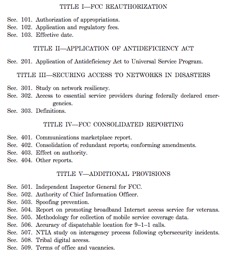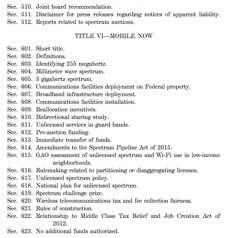Unlicensed Spectrum Provisions in 2018 Omnibus Spending Bill


On March 23 POTUS signed into law the 2018 Omnibus Spending Bill. As a public service, we are providing to the telecom community the sections that deals with telecom issues so readers don't have to plow through all 2000 pages. The index of the telecom provisions is given above.
Since CTIA and NAB will quickly tell their members about the sections that direction affect them - while they claim credit for these provisions, we will not address such issues here. Rather we will focus here on the unlicensed spectrum issues in the new law.
SEC. 603. IDENTIFYING 255 MEGAHERTZ
This section requires NTIA and FCC to identify "identify a total of at least 255 megahertz (sic) of Federal and non-Federal spectrum for mobile and fixed wireless broadband use." It further specifies that "100 megahertz below the frequency of 8000 megahertz shall be identified for use on an unlicensed basis" and that "55 megahertz below the frequency of 8000 megahertz shall be identified for use on either a licensed or unlicensed basis, or a combination of licensed and unlicensed." Thus 100 -155 MHz of spectrum will become available for unlicensed uses, presumably from spectrum used in whole or part by federal users, in the next few years.
SEC. 611. UNLICENSED SERVICES IN GUARD BANDS
This provision states:
After public notice and comment, and in consultation with the Assistant Secretary of Commerce for Communications and Information and the head of each affected Federal agency (or a designee thereof), with respect to frequencies allocated for Federal use, the Commission shall adopt rules that permit unlicensed services where feasible to use any frequencies that are designated as guard bands to protect frequencies allocated after the date of enactment of this Act by competitive bidding under section 309(j) of the Communications Act of 1934 (47 U.S.C. 309(j)), including spectrum that acts as a duplex gap between transmit and receive frequencies.
Two comments here:
- It is unclear whether the requirement for FCC to consult not only with NTIA but also "each affected Federal agency" is a practical requirement here. It is bad enough that the US has 2 parallel agencies in charge of spectrum policy, but here it appears that Congress may not trust the agency that regulates federal spectrum use on behalf of POTUS.
- It is unclear why this provision was even needed since FCC and NTIA already had the legal authority to do this. So rather than enabling anything, this provision might actually slow it down. Time will tell!
SEC. 615. GAO ASSESSMENT OF UNLICENSED SPECTRUM AND WI-FI USE IN LOW-INCOME NEIGHBORHOODS
(GAO) shall conduct a study to evaluate the availability of broadband Internet access using unlicensed spectrum and wireless networks in low-income neighborhoods.
A odd provision! For example, what does "wireless networks " mean here? In general today's use of "wireless" seems to be the services that members of "CTIA-The Wireless Association" offer. Or perhaps the services regulated by FCC's Wireless Telecommunications Bureau. Neither of which seem to include Wi-Fi®.
"Wi-Fi®", as the ® indicated, is a certification mark of the Wi-Fi Alliance. It would be odd if Congress passed a bill on the availability of Xerox® brand copiers in low income neighborhoods. So why did Congress use "Wi-Fi" here?
Then in Sec. 615(a)(2) the bill requires GAO to "consider and evaluate both "the availability of wireless Internet hot spots and access to unlicensed spectrum in low-income neighborhoods, particularly for elementary and secondary school-aged children in such neighborhoods" as well as "any barriers preventing or limiting the deployment and use of wireless networks in low-income neighborhoods"
While many unlicensed Wi-Fi® networks are free to the users, that is not a requirement of FCC rules. The law is unclear then if both free networks and fee-based subscription networks are intended.
Finally, in the 5 GHz band, the impact of LTE-U on Wi-Fi® networks is not going to be positive, but will be very contentious. Is GAO supposed to reopen this can of worms?
SEC. 617. UNLICENSED SPECTRUM POLICY
Even though the whole concept of "unlicensed spectrum" has a foggy foundation in present law and appears to be a contrition of Sec. 301, this prevision tries to build a better foundation for unlicensed while not explicitly saying it is authorized. The bill states
(a) STATEMENT OF POLICY—It is the policy of the United States— (1) to maximize the benefit to the people of the United States of the spectrum resources of the United States; (2) to advance innovation and investment in wireless broadband services; and (3) to promote spectrum policy that makes available on an unlicensed basis radio frequency bands to address consumer demand for unlicensed wireless broadband operations.(b) COMMISSION RESPONSIBILITIES—The Commission shall ensure that the efforts of the Commission related to spectrum allocation and assignment made available on an unlicensed basis radio frequency bands to address demand for unlicensed wireless broadband operations if doing so is, after taking into account the future needs of homeland security, national security, and other spectrum users— (1) reasonable; and (2) in the public interest
We are troubled by the requirement to take "into account the future needs of homeland security, national security, and other spectrum users". While CTIA is now supporting the use of 6 GHz C band spectrum for unlicensed use, perhaps in exchange for the unlicensed community supporting their access to the 4 GHz part of the band, we are aware of no previous occasion when CTIA has every supported the designation of ANY spectrum for unlicensed use. Indeed, BOTH CTIA and NAB have consistently opposed any new unlicensed bands for decades! After NAB and friends said no new spectrum was needed for the ATSC 3.0 transition, they are now trying to slow down for the umpteenth time TV white space implementation so they can simulcast - something their original petitions said was no necessary! So we are not sure if ANY new unlicensed spectrum could pass the test of not impacting "future needs of homeland security, national security, and other spectrum users". Where the "the public interest" stand with respect to these incumbents?
SEC. 618. NATIONAL PLAN FOR UNLICENSED SPECTRUM
The "plan" is introduced here:
NATIONAL PLAN—Not later than 18 months after the date of enactment of this Act, the Commission, in consultation with the NTIA, shall develop a national plan for making additional radio frequency bands available for unlicensed or licensed by rule operations.
This plan can identify new bands that meet the policy statement in Sec. 617, above, including the issue of the needs "of other spectrum users". Interestingly Sec. 618 (c)(2)(D) then states that new bands must "not significantly impact homeland security or national security communications
systems" — oddly leaving out the phrase "other spectrum users" included in Sec. 617. Does this really mean that NAB and CTIA can object on the basis of their "future needs" but not on the basis of "significant impact". VERY ODD! Possibly a drafting error in a smoke filled room late at night.
CONCLUSIONS
Congress did a lot in this legislation. Much of it was already within the legal jurisdiction of FCC and NTIA. Unless Congress wants to revise such issues ever few years, perhaps it should ask the more basic question as why much of this legislation was needed. Perhaps Congress should be more explicit in telling FCC and NTIA what there general goals and priorities are, and let the agencies implement them subject to oversight.
In general, the spectrum policy resources of BOTH FCC and NTIA are too meager considering the $300+B contribution of spectrum related activities to the GDP. FCC and NTIA spectrum activities cost about $200M annually. Both agencies are user fee supported and there is virtually no opposition among their users to the current fee levels. Whether you want to believe Comm. Rosenworcel's off stated number that Wi-Fi® contributes more than $240 B of economic benefits annually, clearly the FCC's Docket 81-413 decision has had huge economy benefit even though it was almost universally opposed at the time. The "killer app" specific suggestion to use the ISM band for unlicensed use came from an FCC-funded study by MITRE Corp. that cost $56k. The plain truth is that neither FCC nor NTIA have this type of funding any more for independent study of spectrum policy issues although its UK counterpart Ofcom does.
Thus it is not clear if the requirements of this legislation, absent a resource increase for both FCC and NTIA spectrum activities, will result in a net gain of spectrum productivity productivity or just drain resources from other important spectrum efforts.



![Validate my RSS feed [Valid RSS]](valid-rss-rogers.png)

